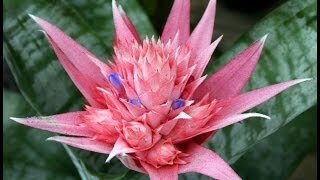The flower of the ehmya is a plant of the bromeliad family, which has an original appearance, affecting the growers with its brightness, color and at the same time unpretentiousness. Therefore, many grow it in apartments. And in the natural environment, ehmya is common in South and Central America and is represented by over 170 species. This representative of the world of flora is very decorative - the flowers are distinguished by their unique beauty, and the leaves are collected in funnel-shaped variegated and monochromatic rosettes.
Popular types of echoes
Ehmeya striped is ideal for growing at home. This species is rooted in Brazil. The plant has an amazing beauty of the inflorescence with pink suckers, which have a delicate shine. The flower blossoms in the middle of summer and pleases its beauty until the winter itself. But note that the striped echmi is a little bit poisonous and can cause skin inflammation.
But the shining Ehmey is considered the most unpretentious. Leaves in her belt-shaped form, from below reddish-violet, and from above - green. The paniculate inflorescence has numerous small bright red flowers with a bluish peak and pink bracts.
Ehmeya: home care
Ehmeya: temperature.
In the summer for ehmeya optimum temperature will be + 20-26, and in winter - + 17-18.The difference between day and night temperatures, as well as access to fresh air, positively affects the ehmeyu.
Ehmeya: lighting.
This plant needs a lot of light, while it reacts normally to direct sunlight, but it can also develop in partial shade. In the apartment it is better to put the ehmeyu near the eastern or western windows. But a flower that has thick, hard leaves will grow well on the south side. In this case, you can only shade it during the hottest hours of the day. In summer, put the ehmeyu on the balcony. So you gradually accustom it to the bright light.
Ehmeya: air humidity.
Ehmeya with dense leathery leaves with high humidity and shade slightly changes its standard color. It ceases to be decorative and becomes more green. But dry air for her is ruinous. Therefore, if the plant hibernates in the heat, sprinkle it daily from a very small sprayer. It also does not hurt to put the pot on a stand with wet pebbles.
Ehmeya: watering.
The soil of the ehmia should be regularly moistened, watering it with warm and soft water. Only first pour the liquid into the rosettes of leaves and only then into the ground. But prolonged drying out is extremely harmful to the plant. Since the fall, the volumes and intensity of watering can be reduced. In winter, this representative of the flora should be watered even less often, and keep the funnel dry.
Ehmeya: fertilizing with fertilizers.
You need to feed ehmeyu in 2-3 weeks in summer and in spring. To do this you will need special liquid fertilizers for flowering or bromeliad plants. Take a half portion.
Ehmeya: transplant.
It is better to replant the ehmey every year. This requires a mixture of light turf, leaf, peat and humus. Take equal shares and do not forget about the admixture of sand. This plant is best developed on humus earth( compost).He also likes leafy ground and chopped moss in equal parts, to which broken shards and sand are added. Not bad ehmeya grows on the substrate from the crushed roots of sphagnum and fern( 1: 3).A mixture of ground peat, coarse leaf earth, sphagnum and sand( the latter should be taken half as much as the rest of the soil) is also suitable. If you prefer the last option, then add pieces of charcoal, horny shavings and provide good drainage.
Related Videos:
 4:02
4:02  8:01
8:01  7:25
7:25 